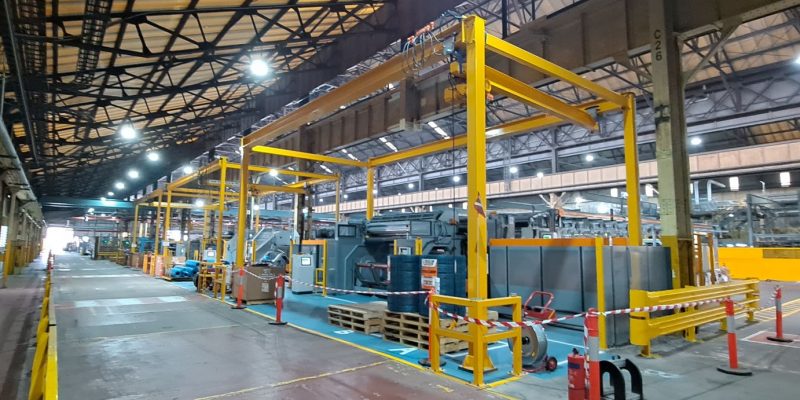Overhead cranes are essential in many industries, including manufacturing, construction, and logistics. They simplify the movement of heavy loads, improve workplace safety, and enhance operational efficiency. Whether handling bulky materials in a warehouse or lifting machinery in a production line, overhead cranes are versatile assets tailored to various needs. We’ll explore the factors to consider when selecting the right overhead gantry crane for your business and how Global Track Australia can support your material-handling needs.
Choosing the Perfect Overhead Gantry Crane for Your Business
Selecting the right overhead gantry crane is a crucial decision that impacts productivity, safety, and cost-effectiveness. To make an informed choice, it’s essential to consider the following factors:
-
Understand the Load and Weight Capacities
The weight of the items you need to lift should always be your starting point. Equipment designed for smaller loads may buckle under excessive weight while overinvesting in a unit with higher capacity than required can be unnecessarily costly. Determine the maximum weight you’ll need to lift and the average load weight. This helps ensure your chosen equipment can handle routine tasks without overexertion while maintaining durability.
-
Evaluate Movement Requirements
Consider the range of motion and direction of movement needed in your operations. For instance, if your tasks involve moving loads across a wide area, a system with extended spans or flexible mobility might be necessary. Equipment with adjustable spans or portable bases can provide the versatility needed in dynamic workspaces.
-
Match the Design to Your Operational Needs
Different designs serve different purposes. Single-beam systems are often suitable for lighter loads and smaller spaces, while double-beam setups are better suited for heavy-duty tasks and greater stability. Modular designs might also be an excellent choice if you foresee changes in your operational setup, as they offer flexibility for future expansions or modifications.
-
Consider the Operating Environment
The physical environment plays a significant role in equipment selection. Indoor facilities with controlled conditions may require different durability than outdoor systems exposed to harsh weather or heavy wear. Additionally, the layout of your space-such as ceiling height, existing structural supports, or potential obstacles-can influence the type of system that fits best.
-
Assess Ease of Operation
It is essential that your workforce is comfortable with the equipment. Look for features that simplify operation, such as user-friendly control panels, wireless controls, or intuitive safety systems. Equipment that is straightforward to use can reduce operator fatigue, improve productivity, and lower the likelihood of errors.
-
Factor in Safety Features
Safety should always be a priority. Opt for equipment with integrated safety mechanisms like overload protection, emergency stop functions, and anti-sway technology. These features safeguard your employees and prevent damage to your facility and materials.
-
Maintenance and Longevity
Long-term reliability is as important as the initial cost. Equipment requiring minimal upkeep but a long service life is ideal for reducing downtime and maintenance expenses. Ensure that spare parts and technical support are readily available, as this will significantly affect the overall cost of ownership.
-
Think About Automation and Technology
Automation is rapidly becoming a game-changer in lifting and material-handling solutions. Incorporating technology like remote controls, data tracking, or predictive maintenance software can boost efficiency and ensure smoother operations. While these features might come with a higher upfront cost, the benefits they bring in reducing labour and operational delays can outweigh the expense.
-
Budget Wisely
Although focusing solely on the price tag is tempting, a cost-effective solution isn’t necessarily the cheapest. Balance your budget against the system’s quality, durability, and long-term benefits. Investing in equipment that meets your operational demands while minimising wear and tear will save you money.
-
Work with Trusted Suppliers
Finally, partner with a reliable supplier who understands your industry and specific requirements. A trusted provider will help you find the most suitable equipment and offer ongoing support, ensuring your system remains efficient and safe throughout its lifespan. By carefully considering these factors, you can ensure that the lifting equipment you select aligns with your business needs, maximises productivity, and fosters a safe working environment. Investing in the right system isn’t just about meeting immediate demands but building a foundation for long-term success.
Elevate Your Operations with Global Track Australia
At Global Track Australia, we specialise in providing tailored solutions for all your lifting and material handling needs. Whether you’re looking for a reliable overhead gantry crane or expert advice on selecting the right equipment, our experienced team is here to help. Contact us today to learn how we can optimise your operations. Call us or visit our website to explore our range of solutions designed to take your business to the next level.


